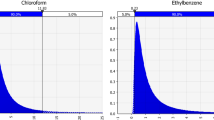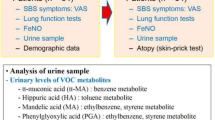Abstract
Objectives
There is growing concern about adverse respiratory health effects from exposure to indoor air pollution. The purpose of this study was to analyze association between exposure to volatile organic compounds (VOC) and asthma in adults.
Methods
This study utilized passive personal exposure data on ten VOC collected as part of the National Health and Nutrition Examination Survey (NHANES) 1999–2000. A total of 550 subjects who were of non-Hispanic whites, Mexican-Americans, or non-Hispanic Blacks race/ethnicity were included in this analysis. The primary outcome variable was physician-diagnosed asthma and the secondary outcome variable was presence of wheezing in the previous 12 months among those without physician-diagnosed asthma. Exploratory factor analysis was used to generate factor scores to group VOCs, which were included as indicator variables in the analyses. Associations between exposure to VOCs, physician-diagnosed asthma, and wheezing in the previous 12 months were evaluated using multiple logistic regression analyses. Odds ratios are for 1-U increase in level of exposure.
Results
Seven of the ten VOC variables loaded on two factors, “aromatic compounds” and “chlorinated hydrocarbons.” The geometric mean concentration of VOCs varied from as low as 0.03 μg/m3 for trichloroethene to as high as 14.33 μg/m3 for toluene. Mexican-Americans had the highest personal exposures to benzene (geometric mean = 2.38 μg/m3) as compared to non-Hispanic whites (geometric mean = 1.15 μg/m3) and non-Hispanic Blacks (geometric mean = 1.07 μg/m3). The odds of physician-diagnosed asthma were significantly higher among those exposed to aromatic compounds (Adjusted OR = 1.63, 95% CI: 1.17–2.27). Among those subjects never diagnosed by a physician to have asthma, a significantly increased odds of one to two wheezing attacks were observed for aromatic compounds (Adjusted OR = 1.68, 95% CI: 1.08–2.61) and chlorinated hydrocarbons (Adjusted OR = 1.50, 95% CI: 1.01–2.23) as compared to no wheezing. No association with three wheezing attacks or more was observed in the study.
Conclusion
In this cross-sectional study of a representative sample of the US population, environmental exposures to VOCs, especially aromatic compounds, were associated with adverse respiratory effects.

Similar content being viewed by others
References
Agency for Toxic Substances and Disease Registry (ATSDR) (1997) Toxicological profile for tetrachloroethylene (PERC). US Department of Health and Human Services, Public Health Service, Atlanta, GA
Aggazzotti G, Fantuzzi G, Righi E et al (1994) Occupational and environmental exposure to perchloroethylene (PCE) in dry cleaners and their family members. Arch Environ Health 49:487–493
Bernard A, Carbonnelle S, Michel O et al (2003) Lung hyperpermeability and asthma prevalence in schoolchildren: unexpected associations with the attendance at indoor chlorinated swimming pools. Occup Environ Med 60:385–394
Boulet LP (1988) Increases in airway responsiveness following acute exposure to respiratory irritants. Reactive airway dysfunction syndrome or occupational asthma? Chest 94(3):476–481
Briggs D (2003) Environmental pollution and the global burden of disease. Br Med Bull 68:1–24
Cakmak A, Ekici A, Ekici M, Arslan M, Iteginli A, Kurtipek E, Kara T (2004) Respiratory findings in gun factory workers exposed to solvents. Respir Med 98:52–56
Centers for Disease Control, Prevention (2004) Asthma prevalence and control characteristics by race/ethnicity-United States, 2002. MMWR 53:145–148
Environmental Protection Agency (2005a) Sources of indoor air pollution—respirable particles. Available at http://www.epa.gov/iaq/rpart.html. Site last updated on 6th October
Environmental Protection Agency (2005b) Sources of indoor air pollution—organic gases (Volatile Organic Compounds—VOCs). Available at http://www.epa.gov/iaq/voc.html. Site last updated on 6th OctoberEnvironmental Protection Agency (1997) Exposure factors handbook. Technical report, US EPA, National Center for Environmental Assessment
Hornung RW, Reed LD (1990) Estimation of average concentration in the presence of nondetectable values. Appl Occup Environ Hyg 5:46–51
Institute of Medicine (2000) Asthma and indoor exposures: indoor chemical exposures. In: Cleaning the Air. National Academy, Washington, DC. http://books.nap.edu/openbook.php?isbn=0309064961
Janson C, Anto J, Burney P, Chinn S, de Marco R, Heinrich J, Jarvis D, Kuenzli N, Leynaert B, Luczynska C, Neukirch F, Svanes C, Sunyer J, Wjst M (2001) The European community respiratory health survey: what are the main results so far? European community respiratory health survey II. Eur Respir J 18(3):598–611
Joseph PM, Weiner MG (2002) Visits to physicians after the oxygenation of gasoline in Philadelphia. Arch Environ Health 57(2):137–154
Moolenaar RL, Hefflin BJ, Ashley DL, Middaugh JP, Etzel RA (1994) Methyl tertiary butyl ether in human blood after exposure to oxygenated fuel in Fairbanks, Alaska. Arch Environ Health 49(5):402–409
National Center for Health Statistics (NCHS) (2006) Centers for disease control and prevention. National health and nutrition examination survey. NHANES 1999–2000. National Center for Health Statistics, Hyattsville, MD. (http://www.cdc.gov/nchs/data/nhanes/frequency/lab21_doc.pdf). Accessed 2 Feb 2006
NHLBI. National Heart, Lung and Blood Institute National Asthma Education and and Prevention Program (1997) Expert panel report 2: guidelines for the diagnosis and management of asthma. National Institutes of Health Publ., No. 97-4051, Bethesda, MD
Norback D, Bjornsson E, Janson C, Widstrom J, Boman G (1995) Asthmatic symptoms and volatile organic compounds, formaldehyde, and carbon dioxide in dwellings. Occup Environ Med 52(6):388–395
Popp W, Muller G, Baltes-Schmitz B et al (1992) Concentrations of tetrachloroethene in blood and trichloroacetic acid in urine in workers and neighbours of dry-cleaning shops. Int Arch Occup Environ Health 63(6):393–395
Rumchev K, Spickett J, Bulsara M, Phillips M, Stick S (2004) Association of domestic exposure to volatile organic compounds with asthma in young children. Thorax 59:746–751
Sexton K, Adgate JL, Ramachandran G, Pratt GC, Mongin SJ, Stock TH, Morandi MT (2004) Comparison of personal, indoor, and outdoor exposures to hazardous air pollutants in three urban communities. Environ Sci Technol 38:423–430
Thickett KM, McCoach JS, Gerber JM, Sadhra S, Burge PS (2002) Occupational asthma caused by chloramines in indoor swimming-pool air. Eur Respir J 19:827–832
Toren K, Brisman J, Jarvholm B (1993) Asthma and asthma-like symptoms in adults assessed by questionnaires. A literature review. Chest 104:600–608
Wallace LA, Pellizzari ED, Hartwell TD et al (1987) The TEAM (Total Exposure Assessment Methodology) study: personal exposures to toxic substances in air, drinking water, and breath of 400 residents of New Jersey, North Carolina, and North Dakota. Environ Res 43(2):290–307
Wallace L, Nelson W, Ziegenfus R, et al (1991) The Los Angeles TEAM study: personal exposures, indoor-outdoor air concentrations, and breath concentrations of 25 volatile organic compounds. J Expo Anal Environ Epidemiol 1:157–192
White MC, Johnson CA, Ashley DL, Buchta TM, Pelletier DJ (1995) Exposure to methyl tertiary-butyl ether from oxygenated gasoline in Stamford, Connecticut. Arch Environ Health 50(3):183–189
Wieslander G, Norback D, Bjornsson E, Janson C, Boman G (1997a) Asthma and the indoor environment: the significance of emission of formaldehyde and volatile organic compounds from newly painted indoor surfaces. Int Arch Occup Environ Health 69(2):115–124
Wieslander G, Norback D, Edling C (1997b) Airway symptoms among house painters in relation to exposure to volatile organic compounds (VOCS)—a longitudinal study. Ann Occup Hyg 41:155–166
World Health Organization (2006) Preventing disease through healthy environments: towards an estimate of the global burden of disease available at: http://www.who.int/quantifying_ehimpacts/global/en/
Author information
Authors and Affiliations
Corresponding author
Additional information
An erratum to this article can be found at http://dx.doi.org/10.1007/s00420-007-0226-8
Rights and permissions
About this article
Cite this article
Arif, A.A., Shah, S.M. Association between personal exposure to volatile organic compounds and asthma among US adult population. Int Arch Occup Environ Health 80, 711–719 (2007). https://doi.org/10.1007/s00420-007-0183-2
Received:
Accepted:
Published:
Issue Date:
DOI: https://doi.org/10.1007/s00420-007-0183-2




